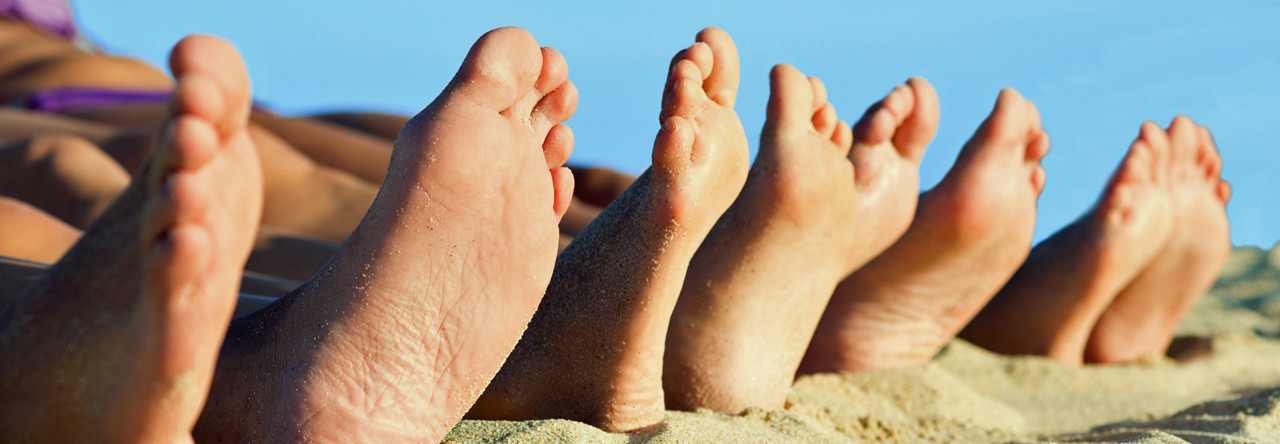The cause of Metatarsalgia (sometimes referred to as ball-of-foot-pain) is usually due to excessive pressure over a long period of time. This all-purpose term indicates a painful foot condition in the metatarsal area of the foot. It is normal to experience acute, recurring, or chronic pain in the the area just before the toes. And sometimes more isolated at the first metatarsal head (near the big toe).
Most often causing the condition are poor fitting footwear or shoes with heels that are too high. Any shoes with a narrow toe or that inhibit the walking process can lead to this extreme discomfort in the forefoot.
Treating metatarsalgia is accomplished by wearing shoes designed with a high, wide toe and a rocker sole. In addition, orthotics designed to relieve ball-of-foot pain usually feature a metatarsal pad. Constructed with the pad placed to redistribute weight from the painful area, these products should provide significant relief.
Category: Metatarsalgia
Morton’s Toe or Morton’s Foot is really common. It’s easy to recognize because the second toe is longer than the Big Toe. In fact, almost everyone has it.
About 50 years ago, Dr. Brian A. Rothbart, DPM, PhD, discovered that when the ankle is aligned close to its optimal functional position to best support the body, the big toe is elevated. When the foot is in its optimal position the big toe is not weight bearing. For many people it doesn’t even touch the ground
However, Morton’s toe can lead to pressure on the second toe (right behind the second toe at the ball- of-the-foot) resulting in pain similar to the discomfort associated with metatarsalgia. The constant pressure placed on the longer second toe while walking or standing can lead to callus formation under the second toe due to pressure.
Selecting proper footwear with a high and wide toe area is ideal for treating this condition. You might even want to buy footwear a half size to a size larger to accommodate your longer second toe.
Sometimes orthotics can be used to keep the foot aligned along with a metatarsal pad to reduce stress on the ball-of-the-foot. Proper footwear combined with an effective orthotic will provide relief from pain associated with Morton’s Toe. read more
Orthotic Shoe Devices
Orthotic shoe devices are molded pieces of rubber, leather, metal, plastic, or other synthetic material that are inserted into a shoe. A foot pad or heel insert are considered an orthotic device, so is a custom molded, individually designed shoe insert or brace. Their purpose is to balance the foot in a neutral position, cushion the foot from excessive pounding and improving the overall function of the foot or ankle.
Custom-made orthotic devices may control pain if you have a specific problem, such as an unusual-shaped foot, or your foot rolls toward the arch (pronation). Custom-made orthotics are available by prescription. Insurance companies differ in how much of the cost they cover.
Some examples, are a wedge inserted into the inner side of the sole of a shoe can be used to help support a flatfoot, thus reducing the risk of tendinitis. An ankle-foot brace can help relieve the pain of rheumatoid arthritis in the heel or ankle. A heel flare can be used to increase support and help prevent ankle sprains. Heel cushions can help absorb impact and relieve stress on the heel and ankle when you walk or run.
Although custom orthoses are considerably more expensive than off-the-shelf devices, they last much longer and provide more support or correction. In some cases, however, an over-the-counter device can be just as effective, particularly when combined with a stretching and exercise program. Before investing in an expensive pair of custom-made orthotics, consider trying good-quality nonprescription orthotics. They can usually be found at drugstores, supermarkets, and sporting goods stores. You can test the effectiveness of several different devices without great expense, which may help you decide whether a more durable custom-made device would be helpful. read more
Surgery of the Foot
By admin
In Ankle Pain, Arthritis, Ball of Foot Pain, Burning Feet, Calcaneocuboid Joint, Callusses, Claw Toe, Corns, Cuboid Fifth Metatarsal, Economy Class Syndrome, Gouty Arthritis, Hammer Toe, Heel Pain, Mallet Toe, Metatarsalgia, Morton's Neuroma, Morton's Toe, Nerve Disorders, Osteoarthritis, Overlapping Toes, Pain Caused by High Heels, Plantar Fasciitis, Plantar Warts, Rheumatoid Arthritis, Side of Foot Pain, Sinus Tarsi Syndrome, Surgery, Toenails
Based on the condition and the chronic nature of the disease, surgery can provide relief of pain and restore mobility in many cases. There have been various modifications and surgical enhancements regarding surgery of the foot. Your podiatric surgeon will determine which method is best suited for you.
There are certain conditions that are commonly relieved through surgical procedures. Most often are Arthritis, Joint Disease, Bunions, Ingrown toenails, Heel Spurs, Neuromas and many foot deformities. read more
